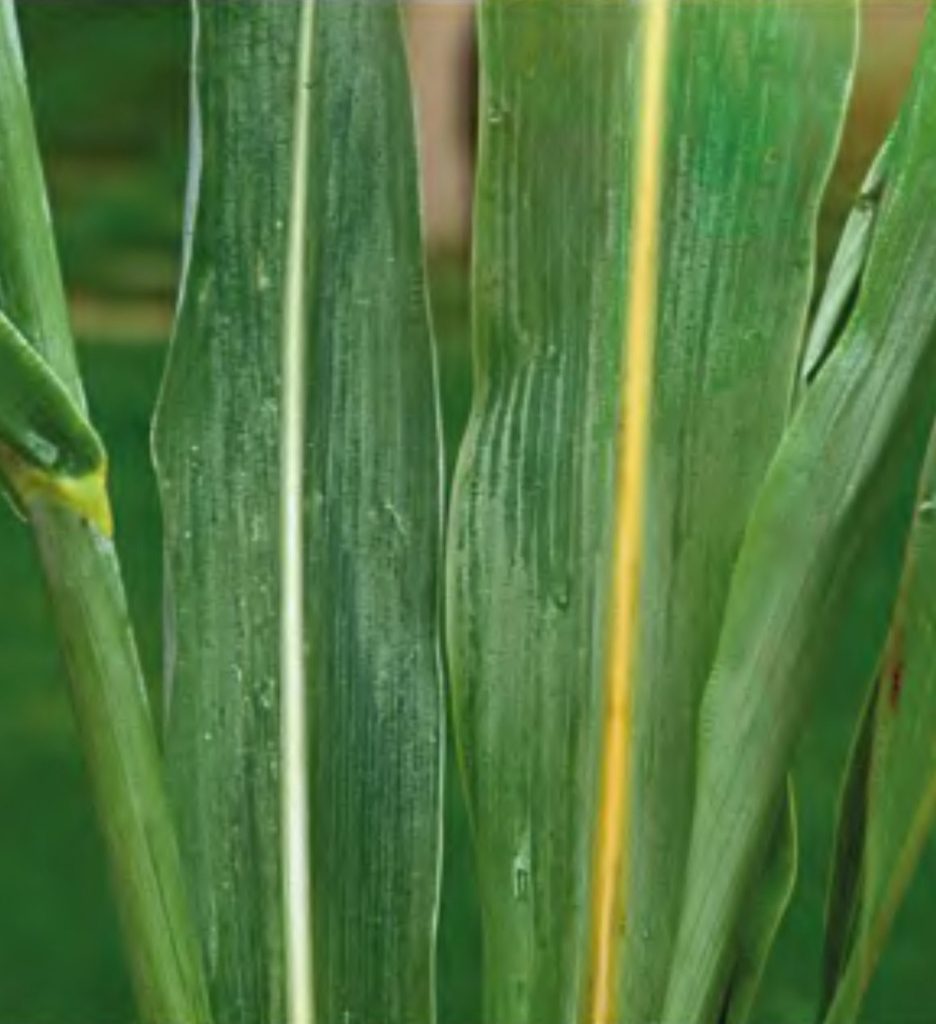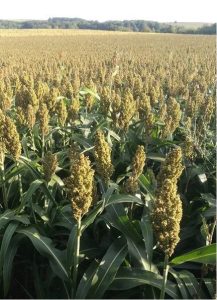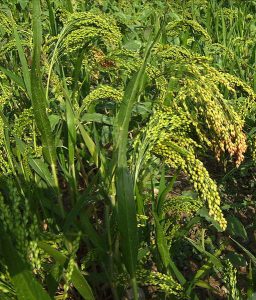Bulletin #2271, Maine Forage Facts: Sorghum, Sudangrass and Sorghum-Sudangrass
Bulletin #2271, Maine Forage Facts: Sorghum, Sudangrass and Sorghum-Sudangrass (PDF)
By Jaime Garzon, Assistant Extension Professor and Forage Educator, University of Maine Cooperative Extension
For information about UMaine Extension programs and resources, visit extension.umaine.edu.
Find more of our publications and books at extension.umaine.edu/publications/.
Sorghum, Sudangrass and Sorghum-Sudangrass
Sorghum and sudangrass are two forages from East Africa, and their crossing produced the sorghum-sudangrass hybrids. These are warm-season grasses adapted to dry or well-drained soils. Each species is unique, and its selection will depend on the farm’s requirements, so it is important to differentiate each species’ specific characteristics and benefits.
Sorghum [Sorghum bicolor (L.) Moench]
Sorghum has different varieties for grain (milo) and forage production. Forage lines have greater leaf growth and crop density. Forage sorghum can reach 8 to 13 feet tall and is widely grown in the south and west of the United States. It can be used for direct animal intake as cut and carry management (green chop), but its greatest potential is as silage, only being surpassed by corn. Forage sorghum is a drought-tolerant species that requires less nitrogen and overall inputs than corn but has a lower starch content.
Sorghum silages are still considered high-energy compared to legumes or cool-season grass silages, especially when harvested at the beginning of flowering, at the soft to medium dough stage. There, the seed heads accumulate the greatest content of soluble carbohydrates, useful for proper silage fermentation.
Forage sorghum should be planted when soil temperatures exceed 65 °F, approximately three weeks after planting corn. In Maine, planting sorghum is recommended in early June. It is advisable to have a seedbed prepared conventionally and sow the seeds at ½ to 1 inch deep. Use 12–15 pounds per acre seeding rate with a conventional small grain drill seeder. Increase the seeding rate by 30 percent when broadcasting. In both cases, ensure seeds are adequately covered and trampled in the soil to increase contact surface, greater germination percentage, and reduced loss by bird’s intake.
It is recommended to test the soil to determine how much fertilizer to use. Soil pH should be between 6 and 7.5, with 6.5 being considered optimum. Without a soil test and assuming moderately fertile soil, apply 150–75–75 per acre of nitrogen, phosphorus, and potassium, respectively. Apply the same quantity of limestone and fertilizer as for corn. Apply nitrogen in two stages, 100 pounds a week after sowing, or when the seedlings are 1–2 inches tall, and the rest after 3-4 weeks of germination. Do not use row fertilizers when seeding with a grain drill.
Silage sorghum production ranges from 3–11 tons of dry matter per acre. Some long-season and/or non-flowering types will need to be killed by frost to dry down enough for ensiling.
Sudangrass [Sorghum × drummondii (Nees ex. Steud.) Millsp. & Chase]
From the same family as sorghum, sudangrass grows from 4–7 feet tall, has leaves about ½ inch wide, and stems about ¼ inch in diameter. Sudangrass has finer stems, profuse tillers, and is leafier than forage sorghums. Their regrowth rate after cutting or grazing is also greater. Therefore, sudangrass’s greatest potential is for direct grazing or hay.
Sow sudangrass when the soil reaches 60–65 °F, around early June in Maine. Adapted to drought and dry soils, this species requires a pH greater than 5.8. Sudangrass is usually seeded with a grain drill at 20–30 pounds per acre using 6 to 7-inch row spacing. Use a roller, a cultipacker, or the tractor wheels to ensure appropriate seed contact with the soil after seeding.
Without a soil test and assuming appropriate soil fertility, apply the equivalent of 50–50–50 of nitrogen, phosphorus, and potassium per acre, respectively. Do not apply fertilizer in contact with the seed. Apply 50 pounds of nitrogen per acre after the first grazing.
Sudangrass should be grazed at the early head or early boot stage. Sudangrass tends to have less prussic acid accumulation than forage sorghums, and this level decreases with maturity. It is best to wait for sudangrass to accumulate at least 20–24 inches of regrowth before grazing. It can be ready for harvest as early as 45 days after planting. Leave at least 5 inches of stubble height to avoid overgrazing and promote good regrowth. Sudangrass yields range from 3–5 tons dry matter per acre.
Do not graze horses in sudangrass. These crops cause cystitis syndrome, a serious condition in horses.
Sorghum-sudangrass
These hybrids were made by crossing different lines or varieties of sorghum with lines or varieties of sudangrass. Due to their higher productivity and stiffer stems, sorghum-sudangrass’s best management is as green chop, but it can also be used for direct grazing. Moreover, these hybrids usually present greater prussic acid concentrations than sudangrass. Larger stems make hay drying more difficult than sudangrasses, so using a mower with a conditioner is advisable if sorghum-sudangrass is directed for hay production.
Sorghum-sudangrass grows in conditions similar to sorghum or corn, performing best in climates with daytime temperatures regularly reaching 90 °F during the growing season. These hybrids need about 45 days for each harvest, so allow at least 90 frost-free days for the entire growing season when taking multiple cuttings. Sorghum-sudangrass does not grow well on poorly drained soils. It prefers loam soils with a neutral pH, even tolerating acidic soils with a 5.5 pH.
Soil temperatures should exceed 65 °F to ensure quick germination. Be sure to plant into a firm and moist seed bed. Seeds should be planted at a ½ inch deep. Suggested seeding rates range from 20–30 pounds per acre drilled to 30–40 pounds per acre broadcast.
Sorghum-sudangrass requires fertilization similar to forage sorghum, equivalent to 150-75-75 of nitrogen, phosphorus, and potassium per acre. Splitting fertilizer applications into equal halves can improve yield and reduce the risk of forage nitrate poisoning when multiple cuttings are planned. Ideally, fertilizer would be applied after emergence, when plants are 1–2 inches tall, and again after the first cutting.
For green chop management, begin chopping after the plant is 18 inches tall or cut at least 7–10 days after a killing frost to avoid prussic acid concerns. Cutting should be done at the start of the heading stage. Once harvested, it should be fed entirely within 4–5 hours. Do not allow green chop to sit any longer; otherwise, potentially dangerous prussic acid levels may build up.
Single cuttings usually achieve the highest yields (6–7 tons of dry matter per acre), but high yields (around 10 tons of dry matter per acre) are still achievable with two cuttings per year.
Do not graze horses in sorghum-sudangrass hybrids. These crops cause cystitis syndrome, a serious condition in horses.
Brown-midrib and brachytic dwarf plant characteristics
These two features were achieved after genetic improvement in sorghum and sudangrass plants. Brown-midrib (BMR) refers to plant varieties with genetically reduced lignin and cellulose and greater soluble nutrient content and digestibility. These plants received this name because the mid-rib or vein that runs down the center of each leaf has a brownish tint instead of the normal whitish color typical in other summer annual grasses. Some BMR sorghum-sudangrass varieties available in Maine’s market are AS6401 (tolerant of higher humidity) and SugarPro (higher digestibility), or AS9302, a BMR dwarf sudangrass variety.
Branchytic dwarf varieties are shorter, leafier, and BMR varieties. Being smaller, the risk of lodging is reduced, and their greatest interest has focused on sorghum. This was achieved after genetically selecting multiple generations of plants, focusing on individuals with shorter stalk internodes, which created compact plants 5–6 feet tall. Even with their smaller size, these plants tiller more than other forage sorghum. In a previous exploration conducted at the University of Maine Cooperative Extension, researchers reported 17 tons yield of dwarf BMR brachytic sorghum (5 tons dry matter per acre), using 5–7 pounds of seed per acre in 30-inch rows. However, the report also informed a slow establishment compared to BMR sorghum, which can put the crop’s performance at risk against invasive weeds.


Sorghums and prussic acid
Sorghum and sudangrass plants may produce a secondary metabolite named dhurrin, which can be transformed later into prussic acid (hydrogen cyanide, HCN) in the digestive system. Sorghum has the highest levels, followed by sorghum-sudangrasses and sudangrass lastly.
Dhurrin content is highest in young plants. Therefore, the recommendation is not to graze or cut for green chop until the plant is 18 to 20 inches tall. Plant stress can also boost dhurrin accumulation, so special care needs to be taken in crops after a strong drought or frost. Do not graze or green chop for seven to ten days after killing frost.
High nitrogen fertilizer or manure levels will increase the likelihood of prussic acid poisoning and nitrate poisoning. Very dark green plant growth often contains higher levels of prussic acid.
Most prussic acid is lost during the curing process. Therefore, hay and silage are rarely toxic, even if the original forage was. Do not leave green chop in a wagon overnight and then feed. The heat that occurs will release prussic acid and increase the likelihood of toxicity in the feed.
References
Boren B, Yost M, Johnson L, Sullivan T, Creech E, Cardon G, Ransom C, Violett R, Reid C, Carrijo DR & Roth GW. (2021). Part I, Section 7, Small Grains. In the 2023-2024 Agronomy Guide. Pennsylvania State University. University Park (PA), United States. pp 112-113. Logan (UT), United States.
Craig P. (2023). Forage Sorghum Planting. Pennsylvania State University Extension. University Park (PA), United States.
Hancock D. (2023). Sorghums, species and varieties. University of Georgia. Athens (GA), United States.
Kersbergen R. (2016). Alternative summer annuals, is there something other than corn silage? In. Cows & Crops Newsletter. October 25. University of Maine Cooperative Extension. Orono (ME), United States.
King’s Agriseeds Inc. Seed catalog.
Thomas-Murphy J, Amsili J, Bergstrom G, Cherney J, Hansen J, Helms M, Hunter M, Kettering Q, Lawrence J, van Es H, Smith E, Smith M, Stanyard M, Workman K. (2023). Cornell Guide for Integrated Field Crop Management. University of Cornell Cooperative Extension. Ithaca (NY), United States. pp 102-103.
Undersander D. (2003). Sorghum, sudangrass, and sorghum-sudangrass hybrids. University of Wisconsin-Madison. Madison (WI), United States.
Zesiger C, Taylor H, Hadfield J, Pace M & Gale J. (2022). Sorghum-sudangrass protection guide. Utah State University.
Information in this publication is provided purely for educational purposes. No responsibility is assumed for any problems associated with the use of products or services mentioned. No endorsement of products or companies is intended, nor is criticism of unnamed products or companies implied.
© 2024
Call 800.287.0274 (in Maine), or 207.581.3188, for information on publications and program offerings from University of Maine Cooperative Extension, or visit extension.umaine.edu.
In complying with the letter and spirit of applicable laws and pursuing its own goals of diversity, the University of Maine System does not discriminate on the grounds of race, color, religion, sex, sexual orientation, transgender status, gender, gender identity or expression, ethnicity, national origin, citizenship status, familial status, ancestry, age, disability physical or mental, genetic information, or veterans or military status in employment, education, and all other programs and activities. The University provides reasonable accommodations to qualified individuals with disabilities upon request. The following person has been designated to handle inquiries regarding non-discrimination policies: Director of Equal Opportunity, 5713 Chadbourne Hall, Room 412, University of Maine, Orono, ME 04469-5713, 207.581.1226, TTY 711 (Maine Relay System).



